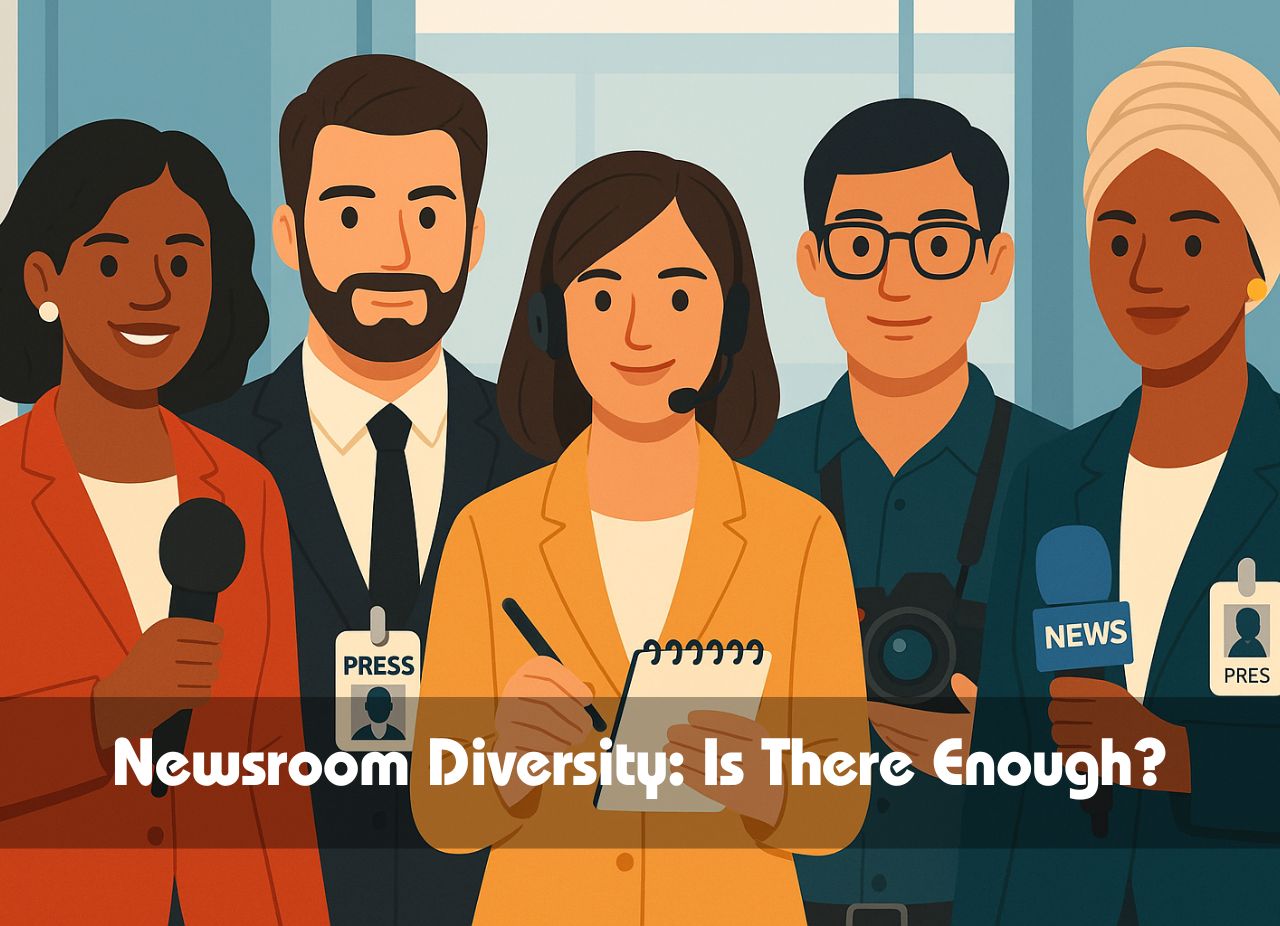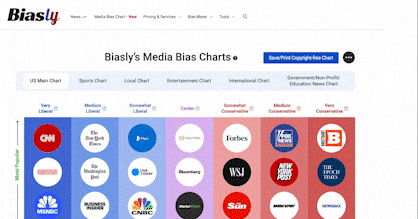
In an age of media polarization, a pressing question has emerged: do newsrooms represent a wide enough range of viewpoints? While many credible outlets prioritize diversity, the lack of ideological variety among journalists affects how the public understands the news, as reflected in media bias chart across major outlets. But how does a newsroom with more variety benefit the wider public?
Lack of divergence in news coverage can lead to biased commentary, lack of nuance, and an increasingly misinformed public. This article will help you understand the nuances of how newsroom diversity, or lack thereof, can affect news coverage and the ways that it impacts the broader population. While no newsroom can be completely free of bias or represent every opinion. But a newsroom with a wider outlook variation leads to more accurate coverage.
What Does It Mean To Have A Diverse Newsroom?
A diverse newsroom has reporters and journalists of different opinions, perspectives, beliefs, and backgrounds. Belief divergence in newsrooms is not to be confused with diversity in newsrooms. Variety in media usually entails a newsroom of people with different genders, races, religions, and ethnicities. That is not to say opinion diversity and diversity cannot overlap, but they are not the same.
Opinion diversity is rather about a variety of different things. Firstly, it is about selecting a talent pool with a wide array of opinions. Furthermore, it is about recruiting a newsroom with a wide variety of different backgrounds. Perhaps most importantly, viewpoint-divergence cultivates a culture with many different beliefs and worldviews.
With an increasingly polarized society, it’s more important than ever for news media to represent various viewpoints, outlooks, and beliefs. The public could become misinformed about countless pressing issues—one of many consequences of unchecked media bias.
Representing different views is necessary to form unbiased, reliable news. For the media to accomplish such a task, a newsroom with many views is necessary. Very often, a belief-divergent newsroom will directly correlate to a diverse newsroom. A diverse newsroom has different workers in terms of gender, background, race, sexuality, and ethnicity.
An outlook-divergent newsroom usually correlates to a news organization with openly opinionated news anchors or a news organization that frequently publishes opinion articles. So we know what belief variety is and why it can be important, but what potential downsides can occur from a newsroom with substantial belief divergence?
What Potential Drawbacks Can Occur From An Opinion-Diverse Newsroom?
A viewpoint-divergent newsroom greatly benefits a news organization, resulting in less biased, higher-quality coverage. However, there is some controversy regarding having belief-diverse newsrooms in both the public and journalism world. So why would a mediaroom with many opinions, beliefs, and worldviews be considered controversial or flawed?
While diversity of opinion in newsrooms is undeniably valuable, one potential concern arises when that diversity includes views that are extremely fringe or conspiratorial in nature. When perspectives cross into territory that contradicts established facts or promotes harmful ideologies, it can compromise the integrity and credibility of journalism.
Ensuring a range of viewpoints is important, but maintaining editorial standards and factual accuracy is equally essential. That said, when thoughtfully managed, a variety of perspectives typically strengthens reporting, encouraging more comprehensive, balanced coverage that reflects the complexity of real-world issues. While diversity of opinion in newsrooms is undeniably valuable, one potential concern arises when that interferes with objective journalism.
Fears of false balance represented in journalism are another controversy and worry that many journalists have regarding opinion diversity. For instance, false balance in journalism can lead to the public having an inaccurate perception of expert consensus on issues. For example, Northwestern researchers conducted a study that concluded that
“False balance reporting can make people doubt the scientific consensus on issues like climate change, sometimes making them wonder if it is an issue to be taken seriously.” – Northwestern Now.
While there are great benefits in having a newsroom with a wide variety of viewpoints, false balance is a real concern. That is not to say that belief-divergent newsrooms are bad or that false balance is inevitable with an opinion-diverse newsroom. Yet, problems and drawbacks need to be addressed regarding an opinion-diverse newsroom. With both the benefits and potential disadvantages, how does a diverse newsroom manifest in practice?
Types of Opinion Diversity in Practice
Many reading this might be wondering, what exactly does diversity in the newsroom mean, not in theory but in practice? How is a newsroom with reporters and journalists with a vast spectrum of opinions different from one with reporters and journalists with similar beliefs in our news world? Newsrooms with broader ideological representation often score lower on media bias and higher on factual reporting.
Variety of thought in newsrooms is not a universal rule, as bias can exist across very diverse viewpoints. However, a larger variety of opinions tends to mean less bias in reporting. For instance, sources like AP News have lower ratings of partisanship than on media bias sites like Biasly. Sites like Biasly use a media bias checker that you can use to check the bias of any source. Biasly uses its AI-powered Bias Meter to determine the media bias ratings of the sources. There are, in practice, numerous types of opinion diversity that exist in newsrooms.
There is political divergence, with reporters and journalists of various viewpoints. There is diversity in regards to gender or sex, which gives a more even perspective of reporting on issues.
Opinion diversity can also include age diversity, which allows for presenting various perspectives on reporting. Opinion diversity can also vary depending on the class or the socioeconomic background of those who work in a newsroom. Reporters of different classes can result in a variety of reporting on inequality and issues of wealth.
There are numerous types of diversity, such as racial or ethnic diversity, often heavily correlated with viewpoint divergence in journalism. However, this does not mean they will always or inherently do so. Without outlook variety, it can be hard to have unbiased and fair reporting on the vast range of issues we face today.
For example, without opinion diversity in journalism, the public could become misinformed about countless pressing issues. Noting the diversity or lack thereof regarding perspectives presented by news sources can educate on the reliability of its reporting.
How To Evaluate News Credibility Using Opinion Diversity
In a connected world, it can be confusing to determine which sources are reliable and which ones are unreliable. How can the average person tell what misinformation is and what accurate reporting is? Unfortunately, there is no one correct answer or silver bullet for ascertaining reliable information. However, evaluating the opinion diversity of a news source can help.
For instance, when researching a source, does the newsroom or reporting staff have employees with a wide diversity of opinions? Or does the media site have a relatively homogeneous reporting staff? An even more reliable way to determine whether a source is biased is to look at several different articles from said source on a similar subject and see if they have the same perspective.
Does the source appear to lean only in one direction, even with numerous different articles and reporters? Or does it have divergent perspectives? Does the source have reporters all leaning towards the same type of bias? Or are the reporters and articles written with various perspectives and biases?
This does not perfectly determine the accuracy of a source, but it can point you in the right direction. If you are worried about false balance, look at the spectrum of arguments made. A thoughtful reader can evaluate news credibility through opinion diversity by examining a source’s perspectives.
How Opinion Diversity Manifests
Opinion Diversity is becoming more common and apparent in newsrooms and journalism, and in our lives and online behavior. Whether accurate or not, the world seems to be becoming more divided and opinionated. And as society has become fractured, it becomes ever more critical for the news to represent those diverse viewpoints. Opinion diversity manifests in sources accumulating journalists with various views and by reliable news sources finding journalists with little bias.
Some news sources will repost or republish articles from both left and right-wing perspectives despite not personally reporting such content. Some less credible sources might fall into false bias by hiring reporters with factually inaccurate views to represent balance.
At the same time, others may go too far in avoiding false balance, which may result in overly biased reporting. More experienced or reliable sources will have a staff with an extensive array of viewpoints while avoiding false balance reporting. Opinion diversity in journalism is quite diverse regarding what that means in practice.
Why Opinion Diversity In Newsrooms Matters More Than Ever
Opinion Diversity may be a rather uninteresting topic for some, but the idea of a diverse news perspective is vital. Viewpoint divergence is necessary in reporting for a balanced perspective. Opinion Diversity can result in less biased, more reliable news reporting, which leads to a more informed populace.
Yet, it can also lead to misinformation or false balance being more accepted. Finally, opinion diversity is becoming more common and necessary in a world that feels increasingly divided by the day. Promoting media literacy training can equip readers to better evaluate opinion diversity and reporting standards.
Incorporating a variety of beliefs in journalism can help reduce the spread of misinformation. So the next time you are looking for a reliable source, ponder the implications of Opinion Diversity in news reporting.


























